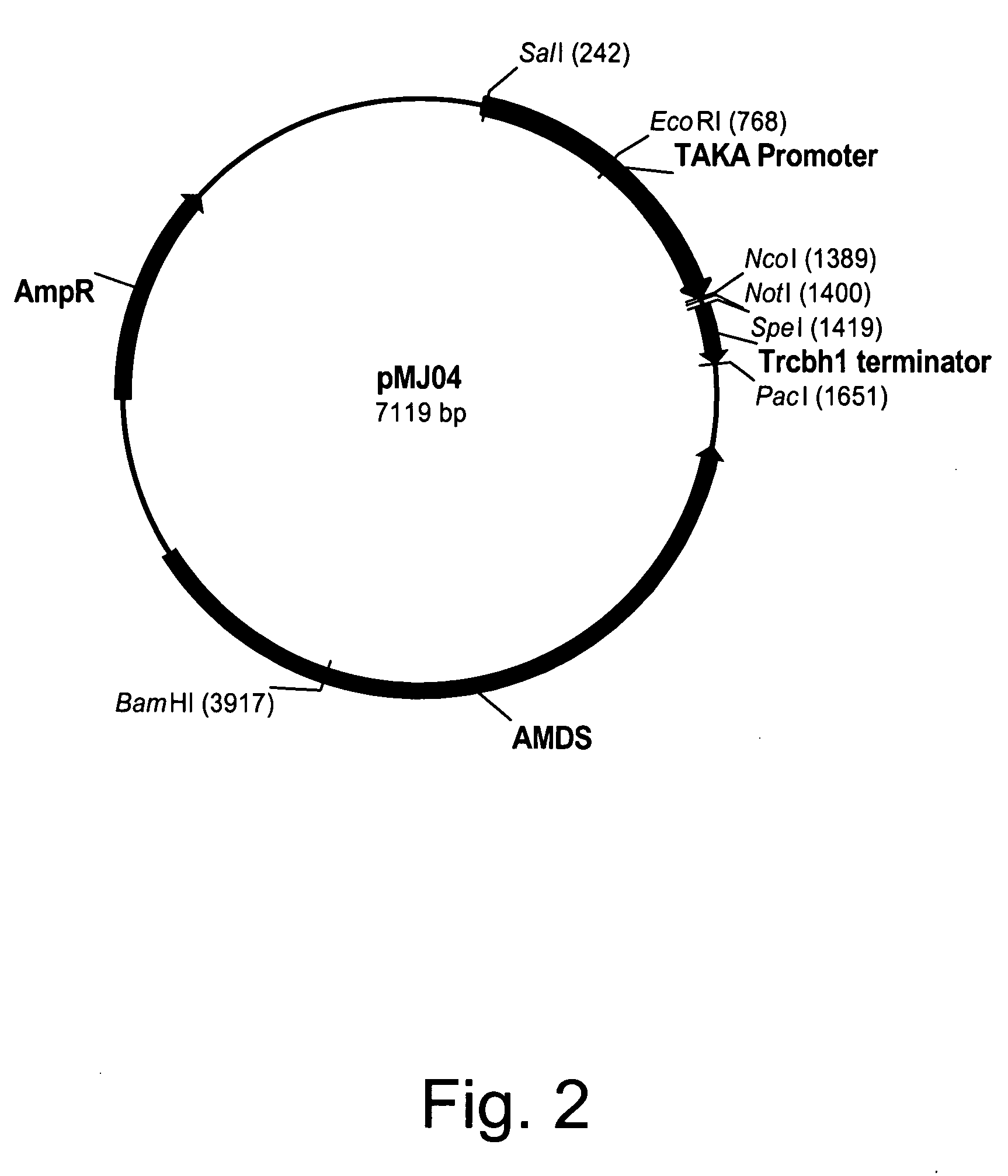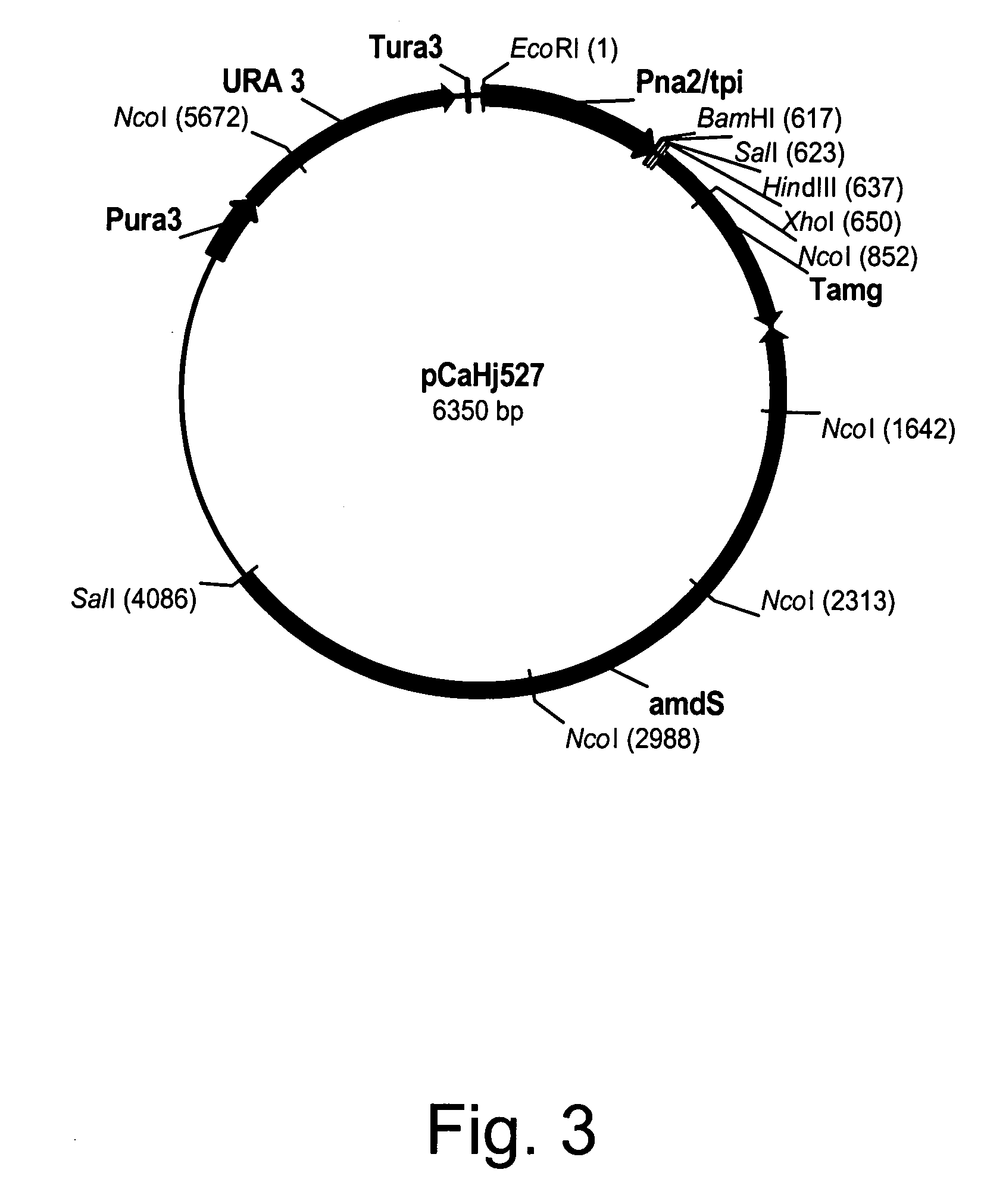Methods for degrading lignocellulosic materials
a technology of lignocellulosic materials and degradation methods, which is applied in the field of degrading lignocellulosic materials, can solve the problems of commercialization and the cost of enzymes to convert lignocellulosic materials into glucose and other fermentable sugars, and no known natural organism can rapidly and efficiently metabolize all carbohydrate polymers in lignocellulosic biomass into ethanol, so as to increase the degradation of lignocellulo
- Summary
- Abstract
- Description
- Claims
- Application Information
AI Technical Summary
Benefits of technology
Problems solved by technology
Method used
Image
Examples
example 1
Construction of pAILo1 Expression Vector
[0192] Expression vector pAILo1 was constructed by modifying pBANe6 (U.S. Pat. No. 6,461,837), which comprises a hybrid of the promoters from the genes for Aspergillus niger neutral alpha-amylase and Aspergillus oryzae triose phosphate isomerase (NA2-tpi promoter), Aspergillus niger amyloglucosidase terminator sequence (AMG terminator), and Aspergillus nidulans acetamidase gene (amdS). Modification of pBANe6 was performed by first eliminating three Nco I restriction sites at positions 2051, 2722, and 3397 bp from the amdS selection marker by site-directed mutagenesis. All changes were designed to be “silent” leaving the actual protein sequence of the amdS gene product unchanged. Removal of these three sites was performed simultaneously with a GeneEditor Site-Directed Mutagenesis Kit (Promega, Madison, Wis.) according to the manufacturer's instructions using the following primers (underlined nucleotide represents the changed base):
AMDS3NcoMu...
example 2
Construction of pMJ04 Expression Vector
[0198] Expression vector pMJ04 was constructed by PCR amplifying the Trichoderma reesei Cel7A cellobiohydrolase 1 terminator from Trichoderma reesei RutC30 genomic DNA using primers 993429 (antisense) and 993428 (sense) shown below. The antisense primer was engineered to have a Pac I site at the 5′-end and a Spe I site at the 5′-end of the sense primer.
Primer 993429 (antisense):5′-AACGTTAATTAAGGAATCGTTTTGTGTTT-3′(SEQ ID NO: 8)Primer 993428 (sense):5′-AGTACTAGTAGCTCCGTGGCGAAAGCCTG-3′(SEQ ID NO: 9)
[0199] The amplification reactions (50 μl) were composed of 1× ThermoPol Reaction Buffer (New England Biolabs, Beverly, Mass.), 0.3 mM dNTPs, 100 ng of Trichoderma reesei RutC30 genomic DNA (which was isolated using a DNeasy Plant Maxi Kit, QIAGEN Inc., Chatsworth, Calif.), 0.3 μM primer 993429, 0.3 μM primer 993428, and 2 units of Vent polymerase (New England Biolabs, Beverly, Mass.). The reactions were incubated in an Eppendorf Mastercycler 5333 (H...
example 3
Construction of pCaHj568 Expression Vector
[0201] Expression plasmid pCaHj568 was constructed from pCaHj170 (U.S. Pat. No. 5,763,254) and pMT2188. Plasmid pCaHj170 comprises the Humicola insolens endoglucanase 5 (Ce / 45A) coding region. Plasmid pMT2188 was constructed as follows: The pUC19 origin of replication was PCR amplified from pCaHj483 (WO 98 / 00529) with primers 142779 and 142780 shown below. Primer 142780 introduces a Bbu I site in the PCR fragment.
(SEQ ID NO: 10)142779:5′-TTGAATTGAAAATAGATTGATTTAAAACTTC-3′(SEQ ID NO: 11)142780:5′-TTGCATGCGTAATCATGGTCATAGC-3′
[0202] The Expand PCR System (Roche Molecular Biochemicals, Basel, Switserland) was used for the amplification following the manufacturer's instructions for this and subsequent PCR amplifications. PCR products were separated on an agarose gel and an 1160 bp fragment was isolated and purified using a Jetquick Gel Extraction Spin Kit (Genomed, Wielandstr, Germany).
[0203] The URA3 gene was amplified from the general Sacch...
PUM
| Property | Measurement | Unit |
|---|---|---|
| water-soluble | aaaaa | aaaaa |
| pH | aaaaa | aaaaa |
| hydrophilic/lipophilic balance | aaaaa | aaaaa |
Abstract
Description
Claims
Application Information
 Login to View More
Login to View More - R&D
- Intellectual Property
- Life Sciences
- Materials
- Tech Scout
- Unparalleled Data Quality
- Higher Quality Content
- 60% Fewer Hallucinations
Browse by: Latest US Patents, China's latest patents, Technical Efficacy Thesaurus, Application Domain, Technology Topic, Popular Technical Reports.
© 2025 PatSnap. All rights reserved.Legal|Privacy policy|Modern Slavery Act Transparency Statement|Sitemap|About US| Contact US: help@patsnap.com



